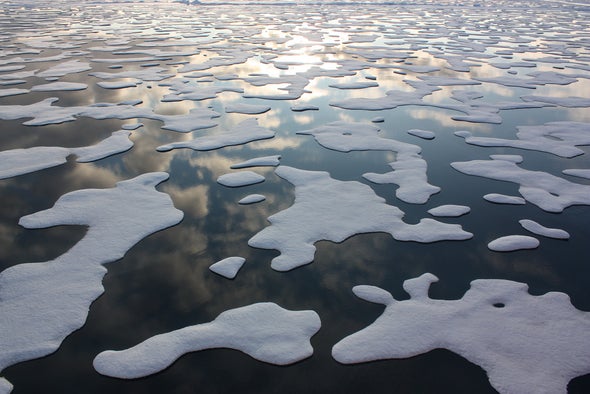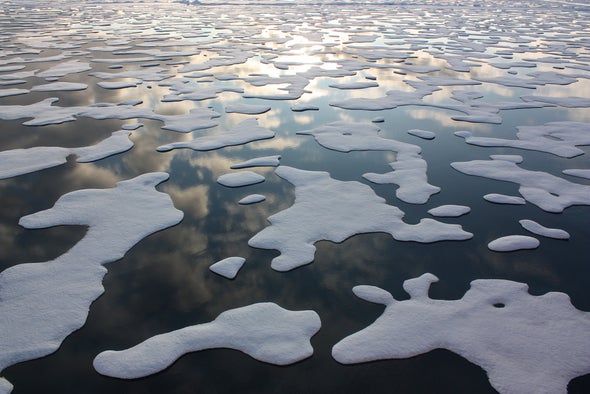Learn about brain health and nootropics to boost brain function
Magnet and Neuron Model Also Predicts Arctic Sea Ice Melt


This May the Arctic sea ice cover was 8.5 percent below the 1981–2010 average—a drop of 436,000 square miles—meaning the ocean is absorbing a lot of sunlight that would normally be reflected. This added heat affects marine ecosystems and may contribute to warming the Northern Hemisphere, so predicting such changes is a key part of modeling what the earth's climate is likely to do. Now a new study offers a model that predicts the formation of telltale "melt ponds" on Arctic sea ice remarkably well—despite being developed in the 1920s to show how objects become magnetic.
The study, published this summer in the New Journal of Physics, vividly illustrates the surprising connections that can exist among seemingly unrelated systems in nature. In 1920 physicist Wilhelm Lenz proposed what is now called the Ising model to study ferromagnets: iron and other materials with inherent magnetic properties. And this is not the first time this model has found an unexpected application; neuroscientists have also used it since the 1980s to study neuron firing.
The common ground among ferromagnets, neuron patterns and melt ponds lies in the mechanism behind the Ising model. Lenz proposed that ferromagnets could be thought of as evenly spaced atoms arranged in a grid, or lattice. His model randomly assigned an upward or downward "spin" (a characteristic that affects magnetization) to each atom in the hypothetical grid; the arrangement of spins determines the state of the system, including the strength of its magnetization and how much energy it has. The more neighboring atoms develop the same spin, the lower the system's overall energy state becomes. And since natural systems tend toward lower energy states, it turns out that the principle behind this model is remarkably versatile.
University of Utah mathematician Kenneth Golden, co-author on the new study, first studied sea ice in high school. He moved on to math as an undergraduate and studied mathematical physics until 1991, when the U.S. Office of Naval Research set up a project to study sea ice using satellite data. As one of very few mathematicians with sea ice experience, Golden signed on. Within 10 years he was learning the ins and outs of field research in the Arctic, and wading deep into melt ponds. But he was still a mathematician at heart. With his recent work connecting the Ising model to larger-scale phenomena still on his mind, he noticed a connection to his icy new passion.
"It just hit me one day," Golden says. "Instead of spin up/spin down [as in the model for ferromagnets], how about water and ice?" In the Ising model "you get these islands of [the same] spins, and I just looked at those things like, 'Man, this looks like melt ponds.'" In the same way the spins of magnetized atoms tend to align with those of their neighbors, a pond surrounded by ice is more likely to freeze over—and ice surrounded by water is more likely to melt.
Golden and his coauthors at the University of Utah, University of Dayton, and Northumbria University in England randomly designated each site on a virtual lattice as ice or water, just as the classic Ising model starts out with randomly assigned up or down spins. Each site was also assigned a height, to mimic the hills and valleys of snow and ice in the Arctic. "We just start off with a purely random initial stage that has very little to do with the actual ponds themselves," Golden says. They then simulated the system evolving according to the rules of nearest-neighbor interactions, with sites changing state to become like most of their neighbors. If there was no majority among the neighbors, a "tiebreaker" rule was applied, based on water's tendency to flow downward. Sites below average elevation defaulted to water, while higher ones became ice. The configuration continued updating until the system's state reached the bottom of an energy "well"—a point of equilibrium at which any change to one site would cause an increase in the system's energy. "The system naturally flows toward these very realistic ponds," Golden says.
The model is incredibly simple; the only measurement used is the length the lattice spacing represents. Donald Perovich of Dartmouth College, who has researched Arctic sea ice for more than 40 years and did not work on the new study (although Golden used his photographs to test the model), says this simplicity is part of what makes the model unique. Previous models were instructive, but highly detailed. Sea ice modeler David Schroeder of the University of Reading and the Center for Polar Observation and Modelling in England, who was also not involved in the study, adds that it provides new information about the patterns melt ponds form on the ice. This, he says, could inform the global climate models that are used to make real-world projections. Because of the way water and ice interact when in contact, the length of the boundaries between the two—determined by the melt ponds' shapes—could affect their evolution. "This aspect is not included in any climate models," Schroeder says.
Nearly 40 years ago John Hopfield, then a professor of chemistry and biology at the California Institute of Technology, had a similar epiphany about modeling memory. Neurons, he figured, also have two states: firing and not firing. And they influence one another's behavior through a process called "autoassociative memory" that enables human brains to remember an entire concept from relatively incomplete clues, says Luca Mazzucato, a neuroscientist at the University of Oregon.
Hopfield's idea led to more realistic models that are now used in applications as diverse as memory loss and seizure treatment. According to these models, memory (as with melt ponds) can be visualized as an energy minimization process—with memories stored at the bottom of energy wells. When prompted by a clue, neuron interactions drive the brain toward the nearest memory. Hopfield was inspired by a more complicated version of the Ising model: individual neurons can influence the entire brain (not just their nearest neighbors), and pairs interact in a variety of ways. These interactions can even change over time, modifying the landscape of available memories to describe learning or forgetting. Simulations based on Hopfield's concept can be used to study memory loss in patients with dementia.
The Ising model provides a rich framework for thinking about the interactions between components of a system in terms of energy. It is a very basic idea, but a powerful one. As Perovich, the sea ice researcher, says, "there's something—to my mind, magical—when you get these mathematical frameworks that explain things as varied as magnetism and melt ponds."
Click here to view full article